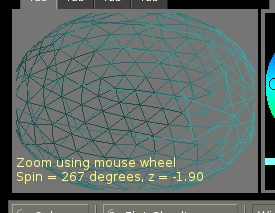SYNOPSIS
#include <agar/core.h> #include <agar/gui.h> #include <agar/gui/opengl.h>
DESCRIPTION
 This manual page documents the OpenGL-specific functions exported by Agar.
These functions are available if Agar was compiled with OpenGL support
(i.e.,
HAVE_OPENGL is defined after including the headers above).
This manual page documents the OpenGL-specific functions exported by Agar.
These functions are available if Agar was compiled with OpenGL support
(i.e.,
HAVE_OPENGL is defined after including the headers above).
Those functions are mostly useful for implementing new OpenGL-based Agar drivers (see AG_Driver(3)). Some of these functions are also useful to simplify texture management when implementing OpenGL-specific Agar-GUI widgets.
OPENGL CONTEXT MANAGEMENT ↑
void AG_GL_InitContext (void *drv, AG_GL_Context *gl)
void AG_GL_SetViewport (void *drv, const AG_Rect *rect)
void AG_GL_DestroyContext (void *drv)
The AG_GL_InitContext() function is to be invoked by OpenGL-specific Agar drivers to initialize the GL context for rendering Agar GUI elements. This involves setting the projection and view matrices as well as various OpenGL options. AG_GL_InitContext() saves the current OpenGL state so that it can be later restored. The gl argument should point to an uninitialized AG_GL_Context structure.
The AG_GL_SetViewPort() function configures the GL viewport. In addition to invoking glViewport(3), this function also updates internal resolution-dependent states.
The AG_GL_DestroyContext() routines frees Agar's internal OpenGL state (restoring the state previously saved in AG_GL_InitContext()).
Multiple-window drivers will typically create a single OpenGL context per window, but single-window drivers may initialize and destroy the GL state more than once (see the AG_DRIVER_SW_OVERLAY option in AG_DriverSw(3)).
TEXTURE/SURFACE MANAGEMENT ↑
void AG_GL_UploadTexture (AG_Driver *drv, Uint *texName, AG_Surface *suSrc, AG_TexCoord *tc)
void AG_GL_UpdateTexture (AG_Driver *drv, Uint texName, AG_Surface *suSrc, AG_TexCoord *tc)
void AG_GL_DeleteTexture (AG_Driver *drv, Uint texName)
void AG_GL_DeleteList (AG_Driver *drv, Uint listName)
void AG_GL_BlitSurface (AG_Driver *drv, AG_Widget *wid, AG_Surface *s, int x, int y)
void AG_GL_BlitSurfaceFrom (AG_Driver *drv, AG_Widget *widSrc, int surfName, AG_Rect *r, int x, int y)
void AG_GL_BlitSurfaceGL (AG_Driver *drv, AG_Widget *wid, AG_Surface *s, float w, float h)
void AG_GL_BlitSurfaceFromGL (AG_Driver *drv, AG_Widget *wid, int surfName, float w, float h)
void AG_GL_BlitSurfaceFlippedGL (AG_Driver *drv, AG_Widget *wid, int surfName, float w, float h)
void AG_GL_BackupSurfaces (AG_Driver *drv, AG_Widget *wid)
void AG_GL_RestoreSurfaces (AG_Driver *drv, AG_Widget *wid)
void AG_GL_RenderToSurface (AG_Driver *drv, AG_Widget *wid, AG_Surface **sDst)
The AG_GL_UploadTexture() operation converts the specified AG_Surface(3) to an OpenGL texture, returning the GL texture handle in texName. Texture coordinates are returned into tc if non-NULL (i.e., X/Y coordinates are 0.0 and width/height are computed from the original dimensions divided by the texture's power-of-two dimensions).
The AG_GL_UpdateTexture() operation uploads a new surface as the specified texture ID. Similarly to AG_GL_UploadTexture(), texture coordinates are returned into tc if non-NULL.
The AG_GL_DeleteTexture() operation arranges for the specified GL texture to be deleted as soon as possible. Unlike a direct call to glDeleteTextures(3), using the AG_GL_DeleteTexture() function is thread-safe.
Similarly, AG_GL_DeleteList() arranges for the given GL display list to be deleted as soon as possible.
The remaining functions AG_GL_BlitSurface(), AG_GL_BlitSurfaceFrom(), etc. are generic OpenGL backends to the corresponding driver surface/texture operations (i.e., blitSurface(), blitSurfaceFrom(), etc.) See AG_Driver(3) for details.
RENDERING PRIMITIVES ↑
void AG_GL_FillRect (AG_Driver *drv, AG_Rect r, AG_Color c)
void AG_GL_PutPixel (AG_Driver *drv, int x, int y, AG_Color c)
void AG_GL_PutPixel32 (AG_Driver *drv, int x, int y, Uint32 c)
void AG_GL_PutPixelRGB (AG_Driver *drv, int x, int y, Uint8 r, Uint8 g, Uint8 b)
void AG_GL_BlendPixel (AG_Driver *drv, int x, int y, AG_Color C, AG_AlphaFn fnSrc, AG_AlphaFn fnDst)
void AG_GL_DrawLine (AG_Driver *drv, int x1, int y1, int x2, int y2, AG_Color C)
void AG_GL_DrawLineH (AG_Driver *drv, int x1, int x2, int y, AG_Color c)
void AG_GL_DrawLineV (AG_Driver *drv, int x, int y1, int y2, AG_Color c)
void AG_GL_DrawLineBlended (AG_Driver *drv, int x1, int y1, int x2, int y2, AG_Color c, AG_AlphaFn fnSrc, AG_AlphaFn fnDst)
void AG_GL_DrawArrowUp (AG_Driver *drv, int x, int y, int h, AG_Color C[2])
void AG_GL_DrawArrowDown (AG_Driver *drv, int x, int y, int h, AG_Color C[2])
void AG_GL_DrawArrowLeft (AG_Driver *drv, int x, int y, int h, AG_Color C[2])
void AG_GL_DrawArrowRight (AG_Driver *drv, int x, int y, int h, AG_Color C[2])
void AG_GL_DrawRectDithered (AG_Driver *drv, AG_Rect r, AG_Color c)
void AG_GL_DrawBoxRounded (AG_Driver *drv, AG_Rect r, int z, int radius, AG_Color C[3])
void AG_GL_DrawBoxRoundedTop (AG_Driver *drv, AG_Rect r, int z, int radius, AG_Color C[3])
void AG_GL_DrawCircle (AG_Driver *drv, int x, int y, int r, AG_Color C)
void AG_GL_DrawCircle2 (AG_Driver *drv, int x, int y, int r, AG_Color C)
void AG_GL_DrawRectFilled (AG_Driver *drv, AG_Rect r, AG_Color c)
void AG_GL_DrawRectBlended (AG_Driver *drv, AG_Rect r, AG_Color c, AG_AlphaFn fnSrc, AG_AlphaFn fnDst)
void AG_GL_UpdateGlyph (AG_Driver *drv, AG_Glyph *glyph)
void AG_GL_DrawGlyph (AG_Driver *drv, const AG_Glyph *glyph, int x, int y)
These functions are generic OpenGL backends to the corresponding driver surface/texture operations (e.g., fillRect(), putPixel(), etc); see AG_Driver(3) for details.
SEE ALSO ↑
HISTORY ↑
The
AG_GL interface first appeared in
Agar 1.4.0.

